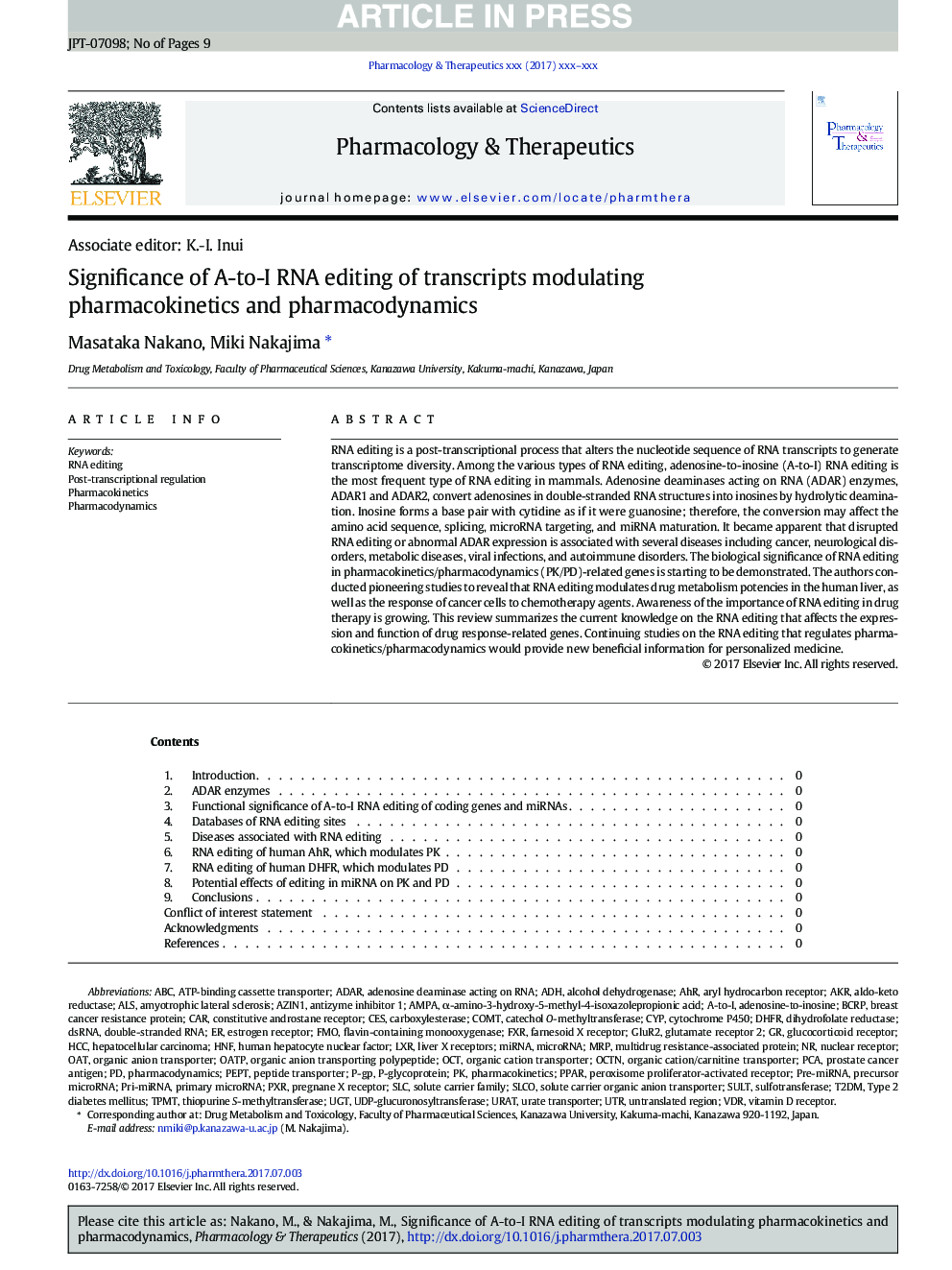| Article ID | Journal | Published Year | Pages | File Type |
|---|---|---|---|---|
| 8536962 | Pharmacology & Therapeutics | 2018 | 9 Pages |
Abstract
RNA editing is a post-transcriptional process that alters the nucleotide sequence of RNA transcripts to generate transcriptome diversity. Among the various types of RNA editing, adenosine-to-inosine (A-to-I) RNA editing is the most frequent type of RNA editing in mammals. Adenosine deaminases acting on RNA (ADAR) enzymes, ADAR1 and ADAR2, convert adenosines in double-stranded RNA structures into inosines by hydrolytic deamination. Inosine forms a base pair with cytidine as if it were guanosine; therefore, the conversion may affect the amino acid sequence, splicing, microRNA targeting, and miRNA maturation. It became apparent that disrupted RNA editing or abnormal ADAR expression is associated with several diseases including cancer, neurological disorders, metabolic diseases, viral infections, and autoimmune disorders. The biological significance of RNA editing in pharmacokinetics/pharmacodynamics (PK/PD)-related genes is starting to be demonstrated. The authors conducted pioneering studies to reveal that RNA editing modulates drug metabolism potencies in the human liver, as well as the response of cancer cells to chemotherapy agents. Awareness of the importance of RNA editing in drug therapy is growing. This review summarizes the current knowledge on the RNA editing that affects the expression and function of drug response-related genes. Continuing studies on the RNA editing that regulates pharmacokinetics/pharmacodynamics would provide new beneficial information for personalized medicine.
Keywords
PXRSLCCOMTMRPBcrpGluR2T2DMFXRdsRNAVDRADARadenosine deaminase acting on RNALXRTPMTABCP-gpOATPFMOpri-miRNAprimary microRNAprecursor microRNASULTPEPTGlutamate receptor 2OCTNA-to-ISLCOAZIN1PPARAKRCyPUGTADHAHRAMPAdhfrfarnesoid X receptorHCCHnfP-glycoproteinPCAdouble-stranded RNAUDP-glucuronosyltransferasealdo-keto reductaseamyotrophic lateral sclerosisα-amino-3-hydroxy-5-methyl-4-isoxazolepropionic acidAlcohol dehydrogenaseOctCESALSThiopurine S-methyltransferaseOaturate transporterorganic cation transporterorganic anion transporterPeptide transporterATP-binding cassette transporterSolute carrier familydihydrofolate reductaseType 2 diabetes mellitussulfotransferaseCytochrome P450PharmacodynamicsPharmacokineticsCARPost-transcriptional regulationUTR یا untranslated regions untranslated regionFlavin-containing monooxygenaseMicroRNAMiRNARNA editingmultidrug resistance-associated proteinbreast cancer resistance proteinOrganic anion transporting polypeptidepre-miRNAcatechol O-methyltransferaseorganic cation/carnitine transporterHepatocellular carcinomacarboxylesterasearyl hydrocarbon receptorconstitutive androstane receptorEstrogen receptorperoxisome proliferator-activated receptorLiver X receptorsVitamin D receptorPregnane X receptorglucocorticoid receptorNuclear receptor
Related Topics
Health Sciences
Pharmacology, Toxicology and Pharmaceutical Science
Pharmacology
Authors
Masataka Nakano, Miki Nakajima,
